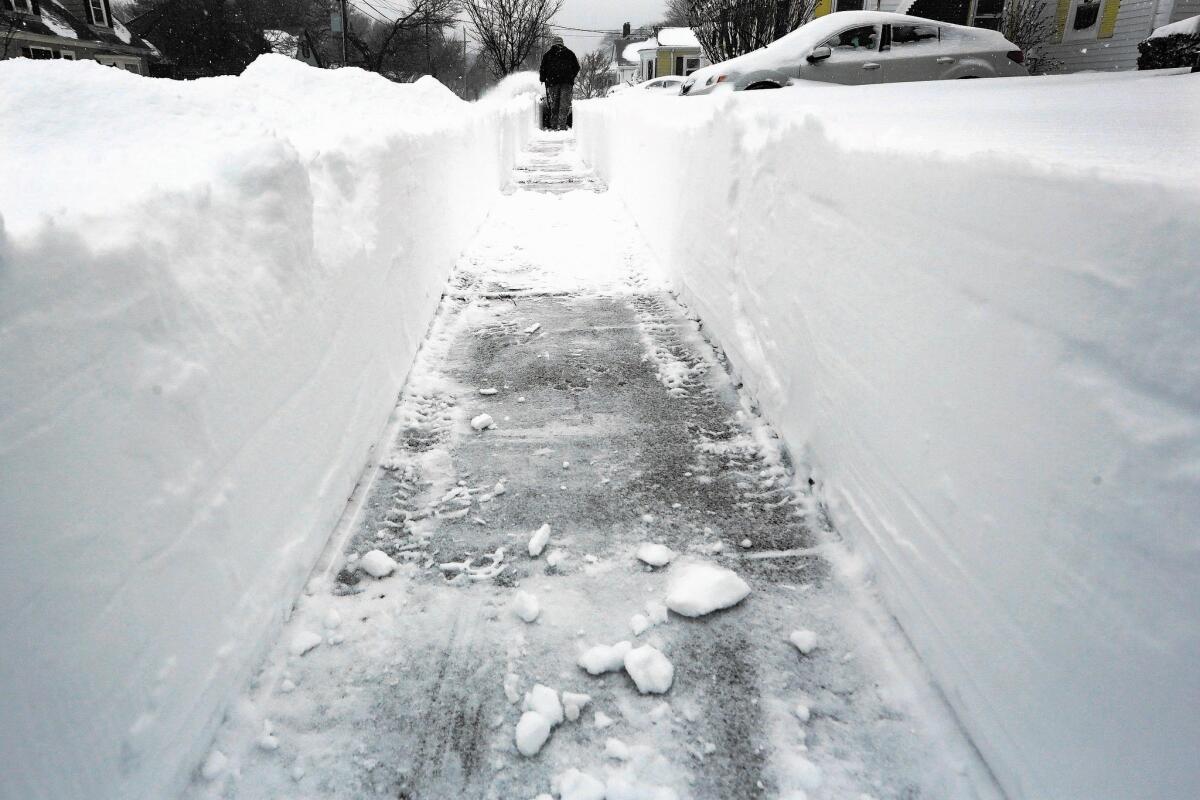‘Snowiest decade’ in a half century? Not exactly, scientists say

- Share via
News outlets pegged it as the “historic” blizzard of 2015.
Snow was supposed to reach unprecedented levels. Flights were canceled, driving bans enforced. New York Mayor Bill de Blasio warned his city to “prepare for the worst.”
For New York and New Jersey, Tuesday’s storm fizzled. But one tantalizing piece of news emerged: A flood of charts and headlines purporting to show that the past decade of winters in the Northern Hemisphere, from 2000 to 2010, was the snowiest since the 1960s. Was it?
As it turns out, it depends on how you look at it. In this case, tallying snow cover only during the winter months can skew the picture, some climate scientists note. What’s just as important — and perhaps more telling when it comes to monitoring climate change, they say — is what happens to snow in the spring.
One particular graphic that was popular on the Web on Tuesday showed the average snow cover during December, January and February. It showed that snow cover in the Northern Hemisphere was about 45.5 million square kilometers — at least 1 million square kilometers more than what it was in most of the 1990s.
“If you wanted to say that there’s no global warming, then, yeah, look at December, January and February,” said Kevin Trenberth, a distinguished senior scientist in the climate analysis section of the National Center for Atmospheric Research in Boulder, Colo. “But as soon as you look at March, April, May and June, you have a very different picture.”
What’s at play with the high winter snowfall, he said, is increased moisture in the air, which leads to bigger snowstorms. And that, says Trenberth, is not a result of colder air, but of warming ocean temperatures.
This is not a simple concept, warns Klaus Wolter, a climatologist at a joint National Oceanic and Atmospheric Administration and University of Colorado research lab.
Wolter has studied trends in extreme storms and concluded in research he published in 2013 that there were no significant trends for snowstorms over the last century. “If you look at the last 50 years, it looks like that last half century is snowier than the earlier one, but there’s still reasonable doubt about the quality of snow measurements before the 1950s,” Wolter said.
The data on snow cover, which have been produced since late 1966, come from the Rutgers University Global Snow Lab, which works with the National Ice Center in Boulder, a joint collaboration with the Navy, the Coast Guard and NOAA to produce the snow maps.
The maps are produced mostly with satellite images, in addition to some measurements gathered on the ground by observers, or by checking Web cameras to see where snow is, said David A. Robinson, state climatologist for New Jersey and director of the Rutgers lab.
“Our database has been the go-to because it’s the longest and most consistent,” he said.
In early winter months, December to February, there’s less variability in snow cover from decade to decade than in the fall or the spring, said Robinson, who was unaware that his lab’s data were used in the charts widely circulated this week showing that the 2000s had the snowiest winters.
But what’s important to keep in mind, according to Rutgers scientists, is that in spring months there has been a steady decline in snow cover for the Northern Hemisphere. When paired with the recent increases in winter snow cover, there’s a stepwise decline in annual average snow cover, Robinson said.
That, some scientists say, must be considered in determining the pace of climate change.
Wolter said there may be an added complication to the reasons behind spring snow decline.
At a workshop he attended last week, the impact of air pollution, particularly from China, was brought up. He said the question of whether the effect of pollution filtering the sun’s rays is a factor in snow decline is unresolved. His research found that the links sometimes drawn between climate change and extreme events are “feeble.”
“There’s still a lot of things to be studied,” he said.
Trenberth doesn’t disagree. Rising sea levels are related to warmer oceans, he said, and the atmosphere above oceans holds about 5% more moisture now compared with measurements from before the 1970s.
He said that increased moisture gets sucked into storms, sometimes from 1,000 miles away, and greater moisture could lead to heavier snow during less frequent snowstorms.
“This whole idea of looking at climate variability and climate change is not as simple as everything all the time going in one direction,” Robinson said.
The Rutgers data on snow cover factors into day-to-day climate research. The snow maps are used primarily for weather forecast models, and knowing the location of snow cover influences temperature forecasts and storm tracking, Robinson said. The maps are also used to study longer-range forecasts to see how snow interacts with the rest of the climate system.
“This is a key means of monitoring climate variability and change,” Robinson said.
Wolter sees correct analysis of snow cover extent throughout the year as being crucial.
“Without that snow, life as we know it, all civilization, would not work,” he said.







